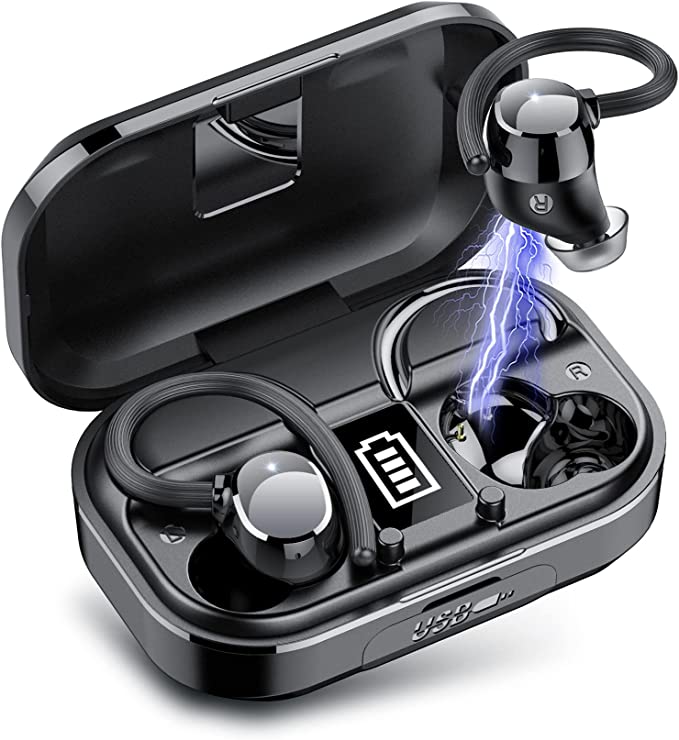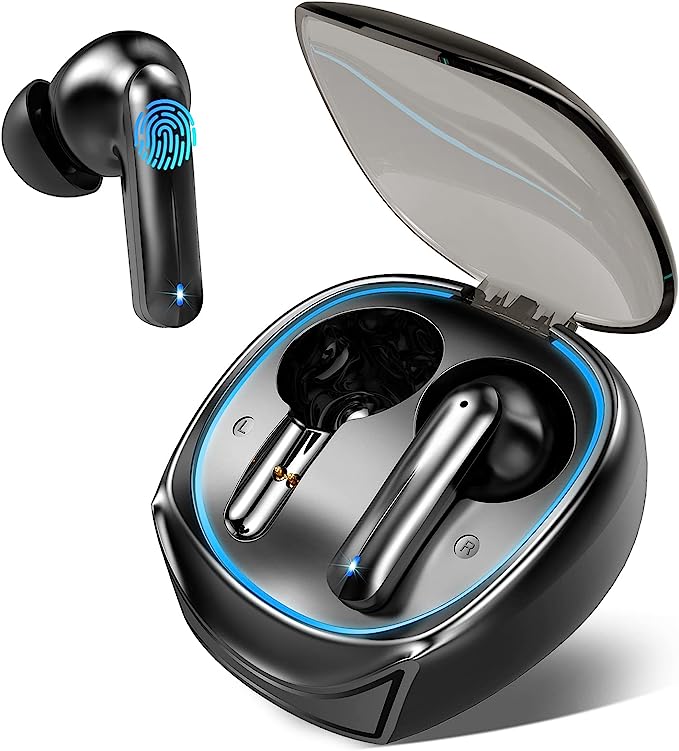Remember the era of tangled headphone cords? That daily battle with knots, the frustrating snag on a doorknob that ripped the buds from your ears? Wireless earbuds promised freedom, a liberation for runners, commuters, and music lovers alike. Yet, early generations often traded one frustration for another: dropped connections mid-song, batteries dying at the worst possible moment, or an earbud tumbling onto the pavement during a workout.
Modern wireless earbuds, however, have evolved significantly. They are marvels of miniaturization, packing sophisticated technology designed to tackle those very challenges. Take, for instance, the VOESUD Q53 Wireless Earbuds. On the surface, they present a list of features common in today’s market. But what’s happening inside? As someone fascinated by audio technology, I believe understanding the science behind the specs empowers us all. So, let’s pull back the curtain and explore the engineering principles that make devices like the Q53 work, using its features, as described by the manufacturer, as our guide.

The Unseen Connection: Making Sense of Bluetooth 5.3
The magic of wireless audio hinges on Bluetooth, that invisible handshake between your earbuds and your phone or computer. It’s a technology that’s been quietly improving over the years. The VOESUD Q53 utilizes Bluetooth 5.3, a relatively recent iteration. But what does that number really mean for you?
Think of Bluetooth evolution like upgrading your internet connection at home. Early versions were like dial-up – they worked, but could be slow and prone to dropping. Newer versions, like 5.3, aim to be more like modern broadband. While the manufacturer of the Q53 claims “3x faster transmission speed” – a specific claim we must attribute to them – the general advancements in Bluetooth 5.3, as defined by the Bluetooth Special Interest Group (SIG), focus on improved efficiency, better handling of crowded radio environments, and potentially more stable connections. This translates to a more reliable link between your device and your ears. Fewer audio stutters when you put your phone in your back pocket, less chance of a dropped signal when walking through a busy area – that’s the goal.
The Q53 also supports standard Bluetooth profiles like HSP (Headset Profile), HFP (Hands-Free Profile), A2DP (Advanced Audio Distribution Profile), and AVRCP (Audio/Video Remote Control Profile). These aren’t just acronyms; they are the agreed-upon languages that allow the earbuds to handle calls (HSP/HFP), stream high-quality stereo music (A2DP), and let you control playback (play, pause, skip) directly from the earbuds (AVRCP). Essentially, Bluetooth 5.3, combined with these profiles, aims to create that seamless, uninterrupted wireless experience we all crave.

Your Personal Sound Bubble: Drivers, Stereo, and the Quest for Bass
Once the signal reliably reaches the earbuds, how does it become sound? The heavy lifting is done by the drivers – the miniature loudspeakers housed within each earbud. Inside each driver is a diaphragm, a thin membrane that vibrates rapidly back and forth, pushing air and creating the sound waves that travel down your ear canal.
The VOESUD Q53 features 13.4mm composite diaphragm drivers. In the world of speakers, generally speaking, a larger diaphragm surface area can move more air. Moving more air is particularly important for reproducing low-frequency sounds – the bass notes that give music its punch and depth. While sound quality is complex and subjective, the use of a relatively large driver (many earbuds use smaller ones) is often associated with the potential for stronger bass response. Indeed, the manufacturer explicitly highlights a “unique stereo design” and “13.4mm big composite diaphragms to produce powerful sound with 40% more bass.” It’s important to note this “40% more bass” is a specific manufacturer claim tied to their design, not an independently verified measurement standard.
The mention of “stereo design” is also key. Stereo sound uses two distinct audio channels (left and right), creating a sense of space and directionality far more immersive than single-channel (mono) audio. This allows you to perceive instruments placed across a soundstage, enhancing the listening experience for music and even movies. Of course, achieving good sound also relies heavily on how well the earbud seals in your ear canal, preventing sound leakage and blocking outside noise – something influenced by the ear tip fit.
Can You Hear Me Now? The Art of Silencing the World on Calls
Using earbuds for phone calls presents a unique challenge: how does the microphone pick up your voice clearly while ignoring the cacophony of the world around you – traffic, wind, coffee shop chatter? This is where sophisticated digital signal processing (DSP) comes into play.
The Q53 description mentions utilizing CVC 8.0 (Clear Voice Capture) technology and features built-in dual microphones, along with a reference to ENC (Environmental Noise Cancellation). CVC, developed by Qualcomm, is a suite of algorithms designed specifically to improve voice clarity during calls. Think of it like a smart filter. The microphones (often multiple, as in the dual-mic setup mentioned) capture all surrounding sound. The CVC algorithms then analyze this soundscape, attempting to distinguish the frequencies and patterns of human speech from background noise. It then digitally suppresses the unwanted noise while trying to keep the voice signal clear. ENC works on similar principles, aiming to reduce environmental disturbances.
The goal, as the manufacturer puts it, is to “effectively remove ambient noise and make calls clearer,” even claiming a significant percentage improvement in clarity. While the actual effectiveness can vary greatly depending on the environment and the specific implementation, the underlying science aims to ensure the person on the other end of the call hears more of you and less of the distracting sounds around you. It’s a constant technological battle against ambient noise, happening right there in your earbud.
Ready for Action: Sweat, Rain, and Staying Put (IPX7 & Ergonomics)
For many users, earbuds are essential workout companions. This demands two things: durability against the elements (namely sweat and maybe rain) and a design that stays put during vigorous movement.
The VOESUD Q53 addresses durability with an IPX7 waterproof rating. This code isn’t just marketing jargon; it refers to a specific standard defined by the International Electrotechnical Commission (IEC 60529). The ‘IP’ stands for Ingress Protection. The ‘X’ means it hasn’t been specifically rated for dust protection. The ‘7’ relates to water protection. An IPX7 rating signifies that the device can withstand being submerged in fresh water up to 1 meter (about 3.3 feet) deep for a maximum of 30 minutes under specific laboratory test conditions.
What does this mean practically? It suggests the Q53 earbuds should handle sweat generated during intense workouts and survive being caught in the rain without issue. However, it’s crucial to heed the manufacturer’s warning: this rating does not mean they are suitable for swimming or wearing in the shower. Water pressure, chemicals (like chlorine or soap), and prolonged submersion go beyond the IPX7 test parameters.
Equally important for active use is the physical fit. The Q53 employs adjustable, secure-fit silicone ear hooks that loop over the top of the ear. From a physics perspective, these hooks provide an additional anchor point, counteracting the forces (gravity, bouncing during running) that might otherwise cause a standard earbud to loosen or fall out. Combined with what the manufacturer describes as a “45 degree in-ear design,” the aim is to create a stable, comfortable fit that remains secure even during high-impact activities. The use of silicone also adds flexibility and softness for long-wearing comfort.

The Power Within: Untangling Battery Life, Charging, and Control
A common frustration with wireless devices is battery life. The Q53 tackles this with specifications promising substantial playtime. The earbuds themselves are stated to offer 8 hours of playback on a single charge. The real endurance, however, comes from the portable charging case. According to the description, this case holds enough power to recharge the earbuds multiple times, offering a total potential playtime of up to 120 hours before the case itself needs recharging via a cable.
This impressive longevity is partly thanks to the use of Lithium Polymer (Li-Polymer) batteries, mentioned as being included. Li-Polymer batteries are common in portable electronics due to their good energy density (storing a lot of power in a small, light package) and ability to be shaped flexibly. The case effectively acts as a mobile power bank specifically for the earbuds.
Keeping track of all this power is aided by the LED digital power display on the case. This allows users to see the remaining charge percentage of the case at a glance, as well as the charging status of the earbuds when they are docked inside – taking the guesswork out of knowing when to recharge. When the earbuds or case do need power, a full charge for the earbuds within the case is stated to take about 1.5 hours.
Beyond power, convenience features streamline the user experience. “One-Step Pairing” means the earbuds are designed to automatically turn on and connect to the last paired device as soon as you open the charging case lid. Touch controls replace physical buttons, allowing users to manage music playback (play/pause, skip tracks) and handle calls simply by tapping the surface of the earbuds. These features, built upon the underlying Bluetooth and processing capabilities, aim to make using the earbuds feel intuitive and seamless.

Conclusion: The Symphony of Technology in Your Ears
So, the next time you pop in your wireless earbuds, take a moment to appreciate the intricate symphony of technologies working together. Within a device like the VOESUD Q53, you have the sophisticated wireless protocols of Bluetooth 5.3 striving for a stable connection, the miniature acoustic engines of the 13.4mm drivers translating electrical signals into sound waves, the intelligent algorithms of CVC/ENC fighting to keep your calls clear, the material science and design principles behind IPX7 waterproofing and ergonomic ear hooks ensuring durability and fit, and the efficient energy storage of Li-Polymer batteries managed by smart charging circuits and displays.
Understanding this science doesn’t just demystify the marketing terms; it empowers you. It helps you appreciate what these tiny gadgets are capable of, understand their limitations (like why IPX7 doesn’t mean swim-proof), and perhaps make more informed choices about the technology you rely on every day. It’s a fascinating world of engineering packed into something small enough to fit in your pocket, constantly evolving to make our wireless lives just a little bit smoother, clearer, and more enjoyable.



